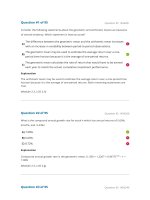Individual assignment topic how are leadership and management different
Bạn đang xem bản rút gọn của tài liệu. Xem và tải ngay bản đầy đủ của tài liệu tại đây (978.01 KB, 15 trang )
MGT103
____
INDIVIDUAL ASSIGNMENT
TOPIC: HOW ARE LEADERSHIP AND
MANAGEMENT DIFFERENT?
Name of Student: Bui Nguyen Phu Qui
Roll Number: CS171577
Class: BA1706
0
0
TABLE OF CONTENTS
I.
Leadership
1. Leadership concept
2. Leadership’s role
3. Characteristics of a leader
4. Qualities of a leader
II.
Management
1. Management concept
2. Integration of different management levels
3. Manager concept
4. Manager function
5. The role of the project manager
III. Similarities between Management and Leadership
IV.
The Difference between Management and Leadership
V.
Relationship between Leadership and Management
VI. References
0
0
I.
Leadership
1. Leadership concept
Leadership has several definitions, but most simply it refers to the ability to influence
others to achieve goals. The processes and attributes needed to effectively influence
others are central to understanding leadership and its value in developing public health
nutrition as a discipline and in practice. our daily. At the core of leadership is credibility,
often achieved by demonstrating ethical and transparent approaches to practice. Leaders
consider risks when necessary, speak out against the status quo, take responsibility, and
demonstrate initiative when necessary. In fact, such behavior requires good strategic
thinking, interpersonal communication skills, and emotional intelligence. In fact, we all
demonstrate and need leadership skills to be effective in our daily practice, whether in
academia, community or organization. We all work to influence others to achieve their
goals, no matter what level we operate in society. Leadership is not limited to the top of
the decision tree but is often required at lower levels to sway branches (Edmonstone J
and Western J., 2002).
0
0
2. Leadership’s role
Leadership quality plays an important role in formulating and consolidating strategy. It
acts as a link linking the heart of the organization to its body. The commitment held by
the leader to accountability encourages institutions to become successful, and this
success comes from making effective decisions for strategy formulation and
implementation. If strategies are not
enacted perfectly, great strategies will be
meaningless. Strategies built below 50%
show the light of adoption because there
is a shortage of leadership skills. Leaders
give direction to the process and ways to
get there. In general, a leader is
responsible for providing a vision, and for
devising strategies that reflect, plan, and
monitor operational undertakings. Leaders
disseminate activities that boost energy
and lift workers' morale and morale.
Leadership is responsible to direct subordinates to perform organizational tasks
effectively (Mason, 2011). We can say that strategic leadership is a process that
transforms an organization into a successful organization through proper strategies. It is
the responsibility of leadership to motivate and inspire the people in the organization to
work jointly so that organization's vision can be translated into reality. Mostly in
organizations, efficient leaders perform the common tasks in the strategy-making and
executing process.
Leadership should use a realistic approach to identify strategic gaps in order to
formulate the right strategies (Fairholm., 2009). According to Sophocles “what you
cannot enforce, do not command”. For effective implementation leaders has to
introduce the need of change. Once the culture has developed the whole procedure of
strategy formulation and implementation would be easy (Fourier & Jacob., 2010).
0
0
3. Characteristics of a leader
In this study, the interaction of leader and member characteristics is explored for its
impact on leader-member relationships. Some support has been found for the
importance of the interaction of leader and member characteristics: leaders with a high
need for power devote more negotiating power to members with a high need for power.
high power needs, while leaders with low power motivation give more negotiating
scope to members with lower power needs. In contrast, there was no support for the
assumed interactive effects of leader and smart member, achievement need, least
preferred co-worker, or position of control on the negotiating latitude of the leader.
members. The results of the study show that the "suitability" of leadership members can
be determined mainly on the basis of the agreement between leaders and members in
how they use power and influence (William E.Mcclane., 1991).
4. Qualities of a leader
There are diverse qualities that make up a good leader and it varies from one
organization/environment to another. The style of leadership may also differ. A leader
may adopt a transformational or transactional leadership style as the case may be
(Hossain., 2015). In the same vein, Hossain (2015) identified twenty-four important
qualities of a good leader in the 21st century. Lencioni (2008) also revealed some
common qualities of successful leaders. Similarly, Sprous (2011) identified five
principal qualities of this
century’s leader. Clark (2010)
also identified five important
qualities of a 21st-century leader.
Similarly, Shah and Pathak (2015)
identify confidence, honesty and
bravery as the most important
qualities of a leader. Archer,
Verster and Zulch (2010)
identified the top qualities of a
good project manager.
0
0
Toor and Ofori (2008) identified the key qualities a leader should possess. The qualities
identified in previous studies are summarized below:
- Hopeful, confident, optimistic, transparent, resilient, ethical, and future-oriented
(Toor and Ofori., 2008)
- Honesty, ability to delegate, communication, sense of humor, confidence, and
commitment (Lencioni., 2008)
- Genuine, self-awareness, leverage, transition, and supportive (Clark., 2010)
- Communication, people skills and decision-making skills, self-discipline,
influence, integrity and reputation, and attitude (Archer et al., 2010)
- Humility, empowerment, collaboration, communication, and fearlessness
(Sprous., 2011)
- Honesty, vision, inspiration, communication, delegation, decision, courage,
fairness, kindness, magnanimity, forward-looking, knowledge, competency,
confidence, commitment, gentleness, accountability, creativity, sense of humor,
intuition, focus, assertiveness, optimism, and balance (Hossain., 2015)
- Confidence and honesty (Shah and Pathak., 2015)
II.
Management
1. Management concept
Management is everywhere, ranging from people’s self-management to social network
management, and from household management to planetary management in the context
of global warming. This raises the question of what is actually meant by the concept of
business management.
Often, management is
self-evidently understood
as managerial power and a
mechanism to control,
inspired by the scientific
management theory that is
still taught in business
schools today. In order to
develop a better
0
0
understanding of the contemporary meaning of the concept, one would expect to find
deeper insights into the sub-discipline of the philosophy of management (Blok, V.,
2019).
2. Integration of different management levels
To determine the management levels upon which sustainability concerns have been
integrated, an evaluation matrix was developed based on the work of Baumgartner
(2014); Appendix F). A few examples of evaluation are shown in Table 3. Starting from
the bottom of
the
framework, in
all companies,
some activities
to support
sustainability
on the
operational
management
level (overview of cases in Table 4) could be identified. In the two companies, no social
projects could be identified in the interviews, on the homepages, or in the
annual/sustainability reports. These companies (3_manuf and 9_manuf) seemed to be
only performing environmental management and did not appear to take any interest in
social sustainability projects. On the strategic management level, eight companies either
include sustainability in their long ‐term goals or had a product/service–market
combination with sustainable offers. Two of these companies have strategically
positioned sustainability ‐related topics in the past but are enexperiencedine in
sustainability integration (thus, marked in yellow–“declined”). In one company,
sustainability was only formally supported before the crisis started (1_manuf). In the
other company(6_manuf_serv), top management changed years ago when the original
owner retired, and the new staff has not displayed an equal interest in ability. Five
companies managed to integrate sustainability on the normative level. Two of these
stated that they struggled with the cultural aspects, as the levels of employee awareness
0
0
and engagement were not considered satisfactory (has declined in 6_manuf_serv and
has not increased on all company sites in 7_manuf_serv). One company(8_manuf_serv)
reported low awareness in some employees, for example, these employees did not take
care of disposable safety equipment. Overall, companies that were considered to have
an open ‐minded organizational culture regarding sustainable development implemented
sustainability either from the bottom up, as was the casewhen the environmental officer
wanted to conduct sustainability.
3. Manager concept
A manager is a professional who takes a
leadership role in an organization and
leads a team of employees (Effectively
Editorial Team., 2021). Managers are
often responsible for managing a specific
department of their company. There are
many types of managers, but they usually
have tasks such as performance
evaluation and decision-making.
Managers are often the channel of
communication between company
employees and senior managers.
4. Manager function
Management competencies can be classified according to four main functions
(including planning, organizing, leading, and controlling) as previously identified
(Moghaddam et al., 2019). The practice of planning includes planning. This is the first
and perhaps most important step in the management process and the findings suggest
that the practice is nearly universal (95%).
Only three (5 percent) participants did not
use the approach in their ward. In one
study, the managerial level of managers
was low. These results follow the same
conclusion. This shows that managers'
management skills are an important factor
in improving job proficiency.
0
0
The lack of these skills caused disorder in the organization. This study also highlights
the importance of developing managers' skills (H. Mousavi. Isfahani et al., 2015).
Supervision or direction is important to improve employee motivation when performing
work so that their performance then becomes better. Monitoring activities can enhance
employee motivation, enthusiasm, and confidence, cause employees to be more
motivated, and improve performance.
Monitoring is important for improving nurses' motivation, morale, and performance in
terms of performing activities including handover (Rina Karmila et al., 2018). Based on
Carpenter's management principles, roles relate to tasks and skills. They can be grouped
into three categories - planning, organizing and leading (Miri et al., 2014).
5. The role of the project manager
Previous studies generally agree that the project manager plays an important role in
achieving project goals and expectations (Kerzner, 2013). Thus, the “project manager”
has been recognized by previous scholars as one of the key factors for success in project
management (Loufrani-Fedida and Missonier, 2015). A professional and effective
project manager not only brings many prospects toward project success, but also
promotes effective project management (Meredith and Mantel, 2011). As a result,
project-based organizations are always focused on identifying, training, and retaining
project managers who can practically manage projects toward success in alignment with
their vision, mission, and vision. Company strategy.
As a result, project-based organizations view the project manager as one of the
company's key assets. However, it is important to note that the project manager's role
can vary depending on the nature of the project, such as the type of project, and the
project's stakeholders (public or private). , project-oriented (temporary or marketoriented), and several projects managed by the project manager at a time (Project
Management Institute, International Journal of Academic Research). Therefore, project
management is also defined as the approach used by project managers to the applicant
of knowledge, skills, tools, and techniques technique for managing project activities
with the ultimate aim of meeting project objectives and stakeholder expectations
(Project Management Institute, 2013).
0
0
III.
Similarities Between Management and Leadership
Although the debate about the relationship between
management/manager and leadership/leader has been present in
management science for decades, there is still no final general
agreement about the
character of the mentioned
relationship. For many years
the prevailing approach,
according to which there is no
relevant equality between
management/manager and
leadership/leader, has been
replaced with a different one
that highlights the high level of overlapping and similarity between
the mentioned categories. Management, Leadership are all activities
of directing, orienting, and controlling the performance of a job
according to a certain purpose. Manage; the leader is all targeted
influence; organization of the subject (manager; leader) to the object
(managed, leadered) to achieve the set goals.
IV.
The difference between management and
leadership
Leadership:
Leadership is an important driving element in setting and achieving
the vision of an organization. It is defined in simplest terms as
“influence” by John Maxwell (Maxwell., 1998). Its definition in a more
detailed explanation is “a behavior; a style; a skill; a process; a
responsibility; an experience; a function of management; a position of
authority; an influencing relationship; a characteristic; and an ability”
0
0
(Northouse., 2007). In expanding this definition, leadership is the
ability of an individual to influence others in achieving desired results.
Peter Drucker explained a leader is a person with followers (Drucker,
1999). A Leader outlines the direction to be followed for his followers,
helps them in seeing the future, and motivates and inspires in
achieving their goals. The influence of leadership is very vital to the
extent that without leadership, a group of individuals often results
into conflicts and arguments because they all have a different
perspective in providing solutions in organizations (Wajdi., 2017).
Although leadership has been defined from different perspectives,
common definitions focus on two aspects which are; influencing
people to achieve desired results and develop a vision. Leaders focus
on motivating and inspiring their followers (Kotter., 1990).
In addition, research findings have shown that qualities such as "trust,
service mentality, good training skills, reliability, competence,
accountability, good listening skills, visionary, realistic, good sense of
priorities, honesty, willingness to share, strong self-esteem. , technical
or contextual and recognition" defines a leader. efficiency (Bennis and
Nanus, 1997). In other words, effective leadership depends on these
qualities and attitudes. Warren Bennis (2009) mentioned that “all
leaders have four essential competencies: they are able to engage
others by creating shared meaning; they have a vision, and they can
persuade others to make that vision their own”. He also added that
“all authentic leaders have a distinctive voice-a purpose, selfconfidence, and all true leaders have integrity-a strong moral
compass”. Furthermore, “leadership is always about character. They
have competenceor adaptive capacity”. This, in Warren Bennis view,
“is what allows leaders to respond quickly and intelligently to
relentless change” in organizations ( cited from Dike., 2015).
Management:
0
0
Management is fairly a new area of study as compared to leadership.
As the industrial revolution took place in the 19th century, complex
organizations also grew and therefore necessitated the need to
regulate workers in organizations. This phenomenon resulted in
managers at work places to guide and reduce confusion among
workers (Kotterman., 2006).
The process of using an administrative or supervisory position to
direct a group of individuals in an organization is management (Katz,
1955). Katz further explained the responsibilities of management to
involve focusing on a given task, training workers to develop their
potential, and solving misunderstandings and conflicts among workers
through work ethics and disciplinary codes (Katz, 1995). According to
Kotter (2001), management is an activity that involves planning,
organizing, coordinating, budgeting, and monitoring people or
organizations. In other term, Northouse defined management as using
efficient resources to achieve desired goals (Northouse, 2007).
Răducan argued that leaders have their own roles and functions in
leadership positions. They organize and coordinate activities, plan,
direct, monitor, and create the necessary and conducive environment
for the employee to increase their performance and efficiency, they
encourage good communication among workers, make sure there is a
good relationship between employees and customers, etc. (Răducan
&
0
0
Răducan, 2014). From the above definitions, management could be
summarized as using resources and the help of others to achieve
institutional or organizational goals.
V.
Relationship between Leadership and
Management
Although leadership and management are similar in some ways, there
are important differences between them. Both managers and
supervisors can play a
similar role,
influencing people to
complete tasks,
directing, assigning
and motivating.
However, supervisors
are involved in
planning and
budgeting, while the manager sets the direction to achieve the goal.
Although managers try to set new goals and align the organization to
them, managers tend to have a short-term goal of maintaining order,
gathering resources, and keeping work organized. Leaders focus on
managing and solving problems, while leaders inspire and motivate
followers (Kotterman., 2006).
Kotterman (2006) argued that the theoretical difference between
managerial and managerial tasks is generally accepted, but not
generally accepted what the functional differences are in practice.
Gordon and Yukl (2004) pointed out that misconceptions about
leadership and management are mutually exclusive when in reality
they are complementary. That is why Yukl (1989) preferred to use the
term "leadership style" in order not to distinguish between the two.
Zaleznik (1998), recognizing the functions of leadership and
0
0
management as complementary, nevertheless argued that they are
definitely separate (cited in Kotterman, 2006). While management
focuses on processes, management deals with change. In short,
management deals with short-term goals tactically, and management
involves strategies to achieve long-term goals (Kotterman., 2006).
Algahtani stated in his research that "Although leadership and
management have similar roles, it is important to distinguish between
the two functions. The primary function of both managers and
supervisors is to control and influence other people. He stated that
the most important difference between leadership and management
it is the way in which the goals of the organization are achieved."
"Leaders exercise their control through formal power, but leaders use
their vision and motivation through inspiration to align their followers"
(Algahtani., 2014).
VI.
References
Hughes, R., Ginnett, R. C., & Curphy, G. J. (1993). Leadership. Public
Health Nutrition, 12(8), 1029.
Jabbar, A. A., & Hussein, A. M. (2017). The role of leadership in
strategic management. International Journal of ResearchGranthaalayah, 5(5), 99-106.
Mcclane, W. E. (1991). The interaction of leader and member
characteristics in the leader-member exchange (LMX) model of
leadership. Small Group Research, 22(3), 283-300.
Olanrewaju, O. I., & Okorie, V. N. (2019). Exploring the Qualities of a
Good Leader Using Principal Component Analysis. Journal of
Engineering, Project & Production Management, 9(2).
0
0
Blok, V. (2020). What Is (Business) Management? Laying the Ground
for a Philosophy of Management. Philosophy of Management, 19(2).
/>Kiesnere, A. L., & Baumgartner, R. J. (2019). Sustainability
management emergence and integration on different management
levels in smaller large-sized companies in Austria. Corporate Social
Responsibility and Environmental Management, 26(6).
/> />Patarru’, F., Weu, B. Y., Handini, F. S., & Heryyanoor, H. (2020). The
Role of the Nurse Unit Manager Function on Nursing Work
Performance: A Systematic Review. Jurnal Ners, 14(3).
/><div class="csl-entry">Gasemagha, A. A., & Kowang, T. O.
(2021). Project Manager Role in Project Management Success.
<i>International Journal of Academic Research in Business and Social
Sciences</i>, <i>11</i>(3). />Simić, I. (2020). Are managers and leaders one and the same?
Ekonomika, 66(3). />JIBREAL, S. (2021). A Theoretical Difference between Leadership and
Management. Sosyal Bilimler ve Eğitim Dergisi.
/>
0
0



